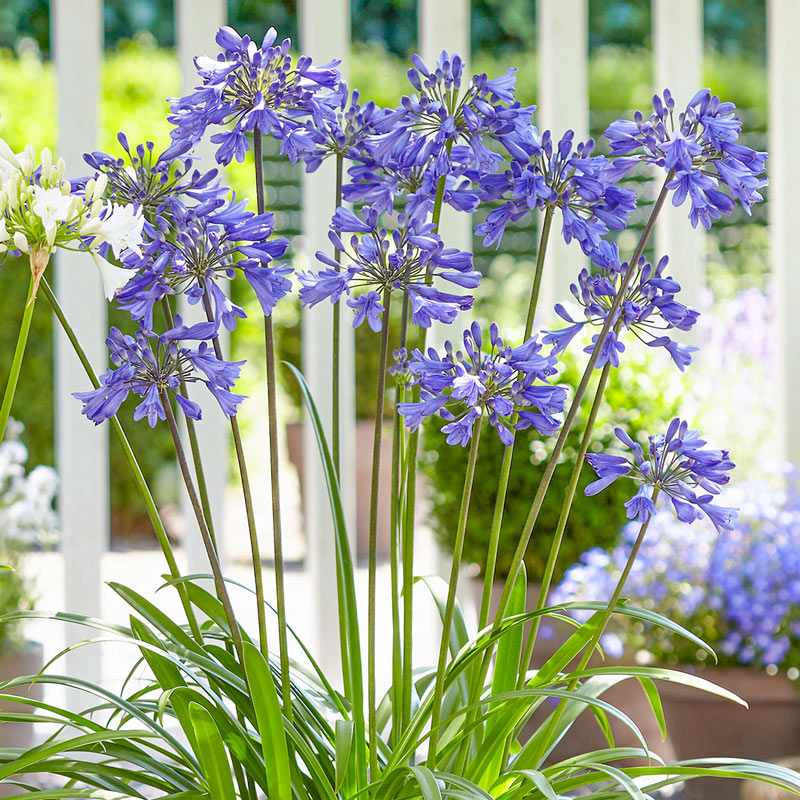Agapanthus Treatment Tips for Lush and Vibrant Flowers
Agapanthus Treatment Tips for Lush and Vibrant Flowers
Blog Article
Grasping the Art of Agapanthus Treatment: Important Actions for Healthy And Balanced Development and Dynamic Blossoms
In the world of gardening, the growing of agapanthus stands as a gratifying endeavor for those who look for to nurture these stylish flowering plants. From picking the best range to grasping pruning techniques, the trip in the direction of cultivating flourishing agapanthus plants is diverse and holds the key to opening the full possibility of these organic gems.

Picking the Right Agapanthus Variety

When picking the right Agapanthus variety for your garden, take into consideration variables such as climate suitability, bloom shade, and development routine. Agapanthus, commonly referred to as Lily of the Nile or African lily, can be found in a range of colors ranging from shades of blue and purple to white. Select a flower color that complements your existing garden palette to create a harmonious landscape. Additionally, think about the environment in your area to make sure the Agapanthus range you choose can prosper in your certain problems. Some selections are a lot more forgiving of chilly temperature levels, while others prefer warmer climates. Comprehending the growth routine of various Agapanthus selections is important for correct placement within your garden. Some ranges have a clumping development routine, suitable for borders or containers, while others have an even more spreading nature, ideal for ground cover or mass growings. By thoroughly examining these aspects, you can choose the excellent Agapanthus range to boost the elegance of your garden.
Ideal Planting Problems
Considering the optimal environmental needs is important for successful Agapanthus growing. Agapanthus plants are delicate to cool temperature levels and ought to be secured from frost throughout wintertime months.
To make sure healthy growth and vivid blossoms, plant Agapanthus bulbs at a depth of concerning 2-4 inches and area them 8-12 inches apart. Mulching around the base of the plants helps retain dampness and reduces weed growth.
Watering and Feeding Tips
Maintaining correct moisture levels and giving necessary nutrients are vital elements in the treatment regimen for Agapanthus plants. When it comes to sprinkling Agapanthus, it is critical to strike a balance. These plants like continually moist soil however are at risk to root rot if overwatered.
Fertilizing Agapanthus is necessary for advertising healthy and balanced growth and respected blossoms. Apply a balanced plant food, such as a 10-10-10 formula, in the early spring as brand-new growth emerges. Repeat this application every 6-8 weeks throughout the growing season. Prevent too much fertilizing, as it can lead to lush foliage at the cost of flowers. Constantly adhere to the supplier's instructions for proper dilution and application methods. By complying with these watering and feeding pointers, you can guarantee your Agapanthus plants thrive and produce dynamic, resilient blossoms.
Trimming Techniques for Agapanthus
Trimming Agapanthus plants at the appropriate times and with proper strategies is critical for preserving their health and advertising ideal growth and blooming. The suitable time to prune Agapanthus is in late winter or very early springtime prior to brand-new growth emerges.
For flowered stems, wait till the blossoms have perished and after that trim them back to the base. This not just tidies up the plant's look however also urges the advancement of brand-new flower buds. Deadheading invested flowers can additionally redirect the plant's power into generating more blossoms as opposed to setting seeds. Nonetheless, if you desire to collect seeds for breeding, leave some blossoms to completely dry and mature on the plant.
Keep in mind to make use of tidy, sharp tools to make exact cuts and lower the danger of presenting conditions. Agapanthus. Regular pruning will certainly assist keep your Agapanthus looking cool and healthy and balanced while ensuring a bountiful display of attractive flowers
Dealing With Common Insects and Conditions
After ensuring appropriate pruning methods for Agapanthus, it is necessary to resolve common pests and illness that can affect the health and wellness and vigor of these plants. Agapanthus plants are usually hardy but can still come down with certain problems. One typical insect that impacts Agapanthus is the Agapanthus gall midge. This small, orange fly lays its eggs in the vegetation, causing altered development and blossom buds that stop working to open. To fight this insect, prune This Site and ruin any type of affected plant parts and consider using insecticidal soap.
One more typical problem is fungal leaf area, which presents as dark lesions on the fallen leaves. To avoid fungal illness, ensure good air flow around the plants, avoid overhead watering, and eliminate any type of contaminated fallen leaves quickly. Furthermore, Agapanthus plants can experience origin rot if they are grown in improperly draining pipes soil. To stop this, plant Agapanthus in well-draining soil and avoid overwatering. By being vigilant and taking timely activity versus conditions and bugs, you can help your Agapanthus plants grow and create vibrant flowers.

Conclusion
To conclude, page grasping the art of agapanthus care involves selecting the best selection, supplying excellent planting conditions, appropriate watering and fertilizing, proper trimming methods, and attending to common bugs and illness. By complying with these necessary actions, you can ensure healthy development and vivid blooms for your agapanthus plants. Remember to regularly keep track of and keep your plants to promote their general well-being and longevity.
To guarantee healthy development and dynamic blossoms, plant Agapanthus bulbs at a deepness of regarding 2-4 inches and room them this website 8-12 inches apart. By following these watering and feeding pointers, you can ensure your Agapanthus plants grow and generate lively, resilient flowers.
One usual insect that affects Agapanthus is the Agapanthus gall midge. Furthermore, Agapanthus plants can suffer from root rot if they are grown in improperly draining soil. By following these crucial actions, you can make certain healthy and balanced growth and vivid blossoms for your agapanthus plants.
Report this page